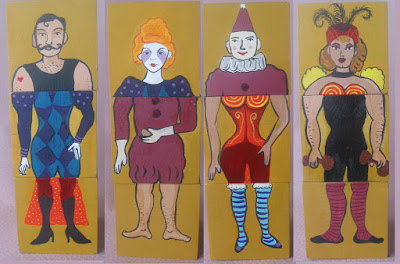Not too long ago I got a chance to visit an exhibit that showcased Alexander Girard's work at the San Francisco Museum of Modern Art. Girard was a designer recognized for his simple designs and his bold use of color. The following panel via
Apartment Therapy immediately made me think of
Otomí paper cutouts! It seemed to me like this design could the a representation of the "Zaki" of a flower. What is "Zaki" you may ask? Read on!
 The Otomí are an indigenous group that pre-dates the Mexica ("Aztecs"). The term was made up by the latter, it means "People that carry arrows". In the group's original language their name was "Ñah-ñu". This group has occupied Central Mexico for thousands of years before the Christian era, and are predecessors to many native groups that currently reside in the area. This region was traditionally woodsy and forest-like, to the unfamiliar, a landscape not generally associated with Mexico.
The Otomí are an indigenous group that pre-dates the Mexica ("Aztecs"). The term was made up by the latter, it means "People that carry arrows". In the group's original language their name was "Ñah-ñu". This group has occupied Central Mexico for thousands of years before the Christian era, and are predecessors to many native groups that currently reside in the area. This region was traditionally woodsy and forest-like, to the unfamiliar, a landscape not generally associated with Mexico.
 Otomí ritual cutout figure: "Zaki" of a Tomato - Seed spirit of a tomato
Otomí ritual cutout figure: "Zaki" of a Tomato - Seed spirit of a tomato
Squirrels, bird, skunks, rabbits and other fauna that reside in the woods show up in
Otomí art and mythology. To this day
Otomí art is deeply influenced by nature, and by the relationship between humans and natural forces.
Otomí paper cutouts are made from amate paper (a type of bark) and are generally symmetrical. They are called
Dahi and serve a ritualistic function, used as a type of fetish that personifies the spirit of an animal or plant. The
Dahi are used as offerings, proxies and intermediaries for protection, healing or fertility. The
Chamanes (doctors, or spiritual healers) use the
Dahi as tools to influence or manipulate a divine current or life-force. The notion of life-force is known in several cultures. In Sanskrit it is called "Prana", "Chi" to the Chinese. In Santeria it is called "Ashe". To the
Ñah-ñu this force is called "
Zaki".
 Otomi ritual cutout figure: Seed spirit of a sweet potato
Otomi ritual cutout figure: Seed spirit of a sweet potatoWhen visiting Santa Fe I was charmed by the many items housed at the
International Museum of Folk Art. At the time I didn't make the connection: most of the items there had been collected (and later donated) by Alexander Girard. Folk art influenced a lot of Girard's work. Some of his work remind me of
Otomí art, mostly because of the symmetry, the clean geometric lines and the natural themes.
 Fruit Tree - fabric by Maximo Inc, from a design by Girard
Fruit Tree - fabric by Maximo Inc, from a design by GirardOne of Girard's most iconic projects was the beloved
La Fonda Del Sol, a restaurant that introduced South of the Border delicacies to New York in 1960. Accounts of diners attending
La Fonda described it as simply joyous. The designer was very interested in creating an atmosphere, an experience influenced by a cohesive design; Girard designed everything, from the table top to the linens. The result was optimisic, bright and colorful. The name of the restaurant adecuately translates as "The Sun's Eatery". Here's an abstract from the Menu:
"This is your house...In this spirit of hospitality, we welcome you to La Fonda Del Sol. Here in an athmosphere relecting all the color, folklore and gaiety of our neigbors to the South, we invite you to enjoy food as it is prepared in the Haciendas and Inns of all the countries under the Latin American Sun".
 La Fonda del Sol. Dinner Menu by Alexander Girard, 1960 via SFMOMA
La Fonda del Sol. Dinner Menu by Alexander Girard, 1960 via SFMOMAFor the Otomi, the most powerful being was
Maka Hyadi, a personification of the sun. It delivered "Zaki" and energy to all living things. Could it be that Girard knew about the
Otomí concept of influencing "Zaki" by means of using artwork? Probably not, but even in a city of steel, concrete and glass he may have known that finding a connection with nature, the joys of food lovingly grown and prepared, and maybe pondering on the misteries of life contained inside a tiny seed provide wonderful experiences.
Links:Otomi paper cut-outs personifying Tomato seeds, and jams come via de
Museum of Anthropology, University of Missouri-Columbia.
To learn more about Otomi paper, ritual and cutouts go to
Mexican Textiles, where you'll find more examples of Otomi art, including a gallery that explains the amate production process.


 This book called to mind my own fuzzy memories of my relatives' homes in Chiapas, and very much like "Casa No Name", the combination of my own unconscious memories and ghost stories evoked images of a Mexico that never existed.
This book called to mind my own fuzzy memories of my relatives' homes in Chiapas, and very much like "Casa No Name", the combination of my own unconscious memories and ghost stories evoked images of a Mexico that never existed.






















